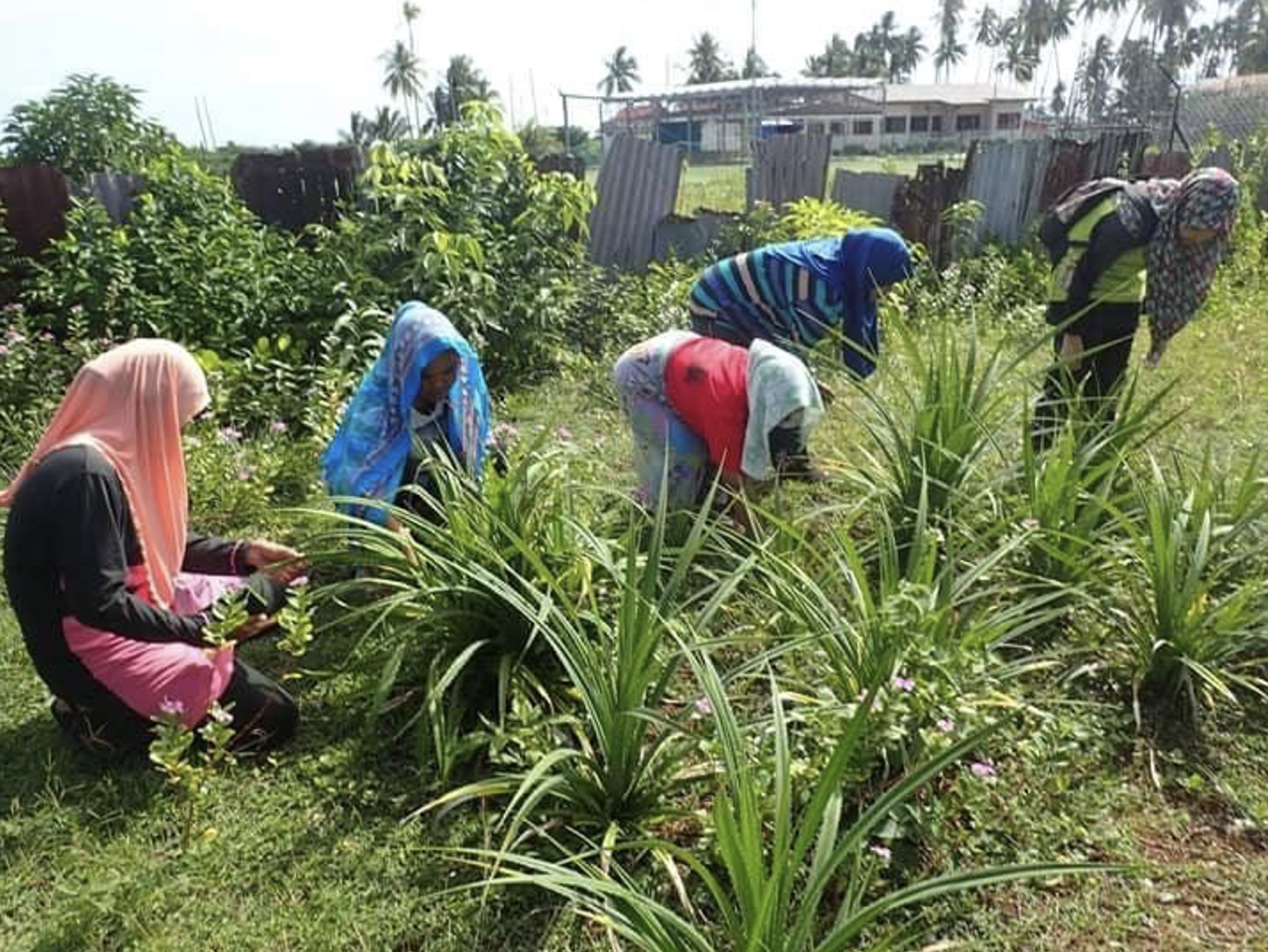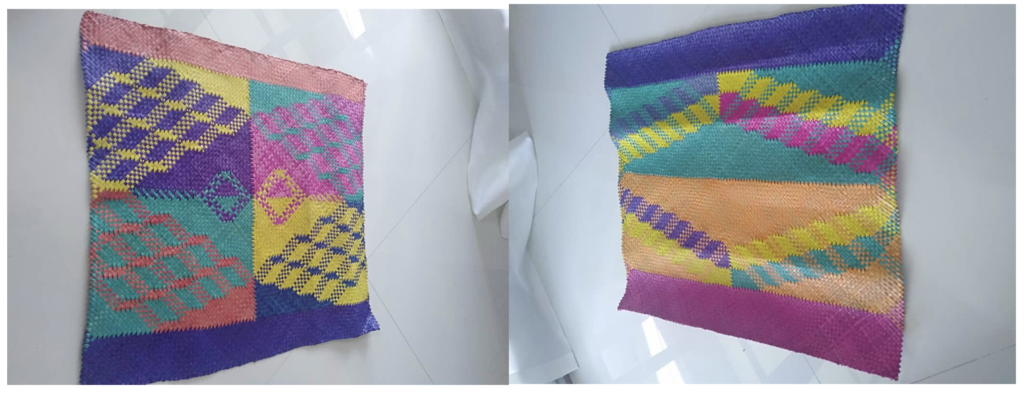
The mat-weaving of tepo, a traditional Bajau woven pandanus mat, is bridging the segregated communities of Bajau Tempatan and Bajau Laut of Omadal Island, Semporna in Sabah.
By YUSRA ZULKIFLI for Lensa Seni
Semporna is home to many islands on the South-East coast of Sabah and world-famous diving destinations. It is also home to the Bajau Laut, who have lived in boathouses traversing the waters of Sabah and the Sulu Archipelago for centuries.
One can find Bajau Laut settlements in various islands within Semporna, such as Mabul, Maiga, Omadal and many more. The Omadal island is considered one of the earliest Bajau Laut settlements in Semporna, as it has centuries-old Bajau cemeteries. Historically, the island was a strategic gateway for traders.
The Omadal island currently has two distinct communities: the Malaysian citizens known as Bajau Tempatan and the stateless Bajau Laut. The Bajau Tempatan community reside on the island, whereas the Bajau Laut live above the waters off Omadal island.
These communities are somewhat segregated. The two communities do not mingle during gatherings and ceremonies with a clear social divide. Even their children do not play together. There is an invisible boundary on the coastal waters of Omadal island that separates these communities, their dwellings and their way of life.
Although they share similar language and culture, the Bajau Laut and Bajau Temptatan do not associate with one another. However, through tepo, they find common ground as they weave the tepo together.
Roziah Jalalid, or Kak Roziah, a Bajau Tempatan from Omadal island, said only a few exchanges and interactions happened between the two communities in the past. Then, they weaved tepo only for home use, but now they weave as a source of income, and they segregate their task amongst the two communities and rely on each other to sell or market their tepo. Therefore, they meet more often these days, and even celebrate Hari Raya Aidilfitri together.
Tepo is a Bajau traditional woven mat used as an everyday domestic object. It is a cultural heritage of the Bajau.

Bajau women are known as good weavers. They weave intricate pandanus mats, which they use for sleeping, receiving guests, wedding gifts and ceremonies. It’s a skill passed down from mothers to daughters, with patterns inspired by their surrounding environment and marine life.
The Bajau Laut appear to be more knowledgeable and skilful weavers than the Bajau Tempatan, as shown by the Bajau Tempatan’s basic patterns such as kusta (kain pelikat or sarong pattern), nijalih (diagonal pattern) and biskut (biscuit pattern).
What makes tepo unique to the Bajau is the intricate, vibrant coloured woven patterns employed for their pandanus mat. The intricate designs require the weaver to master the tinabid technique. This technique allows delicate folds of the pandanus strips to varying angles, which changes the direction of the weave.
With the tinabid technique, the ladies can weave patterns such as Sambulayang (boathouse flag), Nikeyutan (lobster), Harunan Motol (boat steps) and many more. These patterns are sought after for wedding ceremonies and turning them into other handicrafts. However, this particular weaving skill is mainly mastered by the Bajau Laut of Omadal.
Therefore, the Bajau Tempatan and Bajau Laut women work hand-in-hand to improve their livelihood through making tepo and other handicrafts. Both communities have different skill sets that complement each other. They established Wanita Pulau Omadal (WAPO) Association in 2010 with the help of WWF, comprising women from both communities.
According to Kinnuhong Gundasalo, a Bajau Laut weaver, before establishing WAPO, she had less opportunity to weave as she needed to help her husband fish for their daily sustenance and demand for tepo was far less. WAPO haS given her a chance to earn extra income and recall the stories, patterns and songs when they weaved with their mothers and grandmothers.

As there are initial costs to dyeing the pandanus leaves, Kak Roziah said they would help prepare the materials from harvesting the pandanus leaves together and process them to become coloured pandanus strips ready for weaving.
These pandanus strips are given to the Bajau Laut to weave those intricate patterns. Once the Bajau Laut makes the woven mat, it is passed to the Bajau Tempatan, who sew it onto a plain-woven mat. Tepo is a two-layered mat, where the top layer is the intricate multi-coloured woven pandanus mat, and the bottom layer is made of a plain-woven mat.
Yee I-Lann, a contemporary artist from Sabah, has been collaborating with the weavers of Omadal island since 2018. In collaboration with the weavers, AND her artwork has been exhibited internationally in Singapore, the Philippines, South Korea, Hong Kong and Australia.
Her long-term engagement has provided continuous support to both the Bajau Laut and Bajau Tempatan, even during the covid-19 pandemic.
“One of the things I am most proud of is last year – 2020 – the year of the Covid-19 pandemic. I was fully employing up to 30 weavers from Semporna and about nine in Keningau when other work was not available.
“To me, that is part of my ambition – to create sustainable domestic economy using skills and celebrating skills,” Yee was quoted in the Daily Express.
Other NGOs, such as Kraftangan Malaysia, have also provided workshops to the ladies of WAPO to equip themselves with the required skills to make other handicrafts from their tepo. For example, the Bajau Tempatan make bags, wallets, and handbags from the woven pandanus mat.

As they work together, the ladies of Bajau Tempatan will secure grants and funds to support their activities, and the communities share their income and resources. In addition, they actively promote WAPO products by participating in various events in Sabah and Kuala Lumpur.
Through these various engagements with NGOs and Yee I-Lann, Kak Roziah, the chairman of WAPO, expressed that the mat-weaving activity has brought the two communities closer. They even meet daily at times because of their work together.
The weaving of Tepo is bridging the communication and ties between these two distinct communities on Omadal island. Still, the Bajau Laut remains a marginalised society partly due to being undocumented.
Without documentation, they do not have access to public healthcare and education. That results in a lack of means to better themselves to secure formal jobs and trapped in the cycle of poverty.
The ladies of Bajau Tempatan and Bajau Laut capitalise on their mat-weaving tradition to make a living. Mat-weaving becomes the alternative livelihood that supports the weavers economically as they do not need to go fishing with their husbands.
It gives economic and gender empowerment to these indigenous Bajau women. For example, they can support their families by buying boat engines for their sons to go fishing, contributing to wedding ceremonies expenses and building or extending their homes.
They are also reviving their mat-weaving culture as more women participate in mat-weaving activities. Kak Roziah said, “Bajau Laut from other islands moved to Omadal because they want to follow me to participate in the wat-weaving activities.”
Yusra Zulkifli is a participant in the CENDANA ARTS WRITING MASTERCLASS & MENTORSHIP PROGRAMME 2021
The views and opinions expressed in this article are strictly the author’s own and do not reflect those of CENDANA. CENDANA reserves the right to be excluded from any liabilities, losses, damages, defaults, and/or intellectual property infringements caused by the views and opinions expressed by the author in this article at all times, during or after publication, whether on this website or any other platforms hosted by CENDANA or if said opinions/views are republished on third party platforms.
